Make spelling practice easier for your child. Find out how you can teach the spellings of complex words in a systematic and effective way.
In a previous article, we discussed why it’s important for children to have a good working knowledge of phonics if you want them to improve their spelling.
Learning spellings based purely on the visual appearance of words is extremely inefficient.1
Your child can learn to spell hundreds of words with complete accuracy using the basic principles of phonics because around half of all words in the English Language have predictable spellings (once the main letter-sound correspondences have been learned).2
Yet, unfortunately, the English spelling system is complex, and there are many common words where the spellings aren’t completely predictable from basic phonics knowledge.
Nevertheless, it is possible to teach the spellings of these words in a structured way that can simplify the process and improve your child’s spelling skills…
Click here for a summary of this article, or browse the contents of the main article below…
Contents:
- First, Teach Groups of Words With Similar Sounds and Spelling Patterns
- Gradually Increase the Difficulty
- Introduce Words With Alternative Spelling Patterns for the Same Sound
- Mix It Up
- Encourage your child to look out for patterns
- Learning to spell “tricky words”
- Identify What’s Tricky and What’s Not
- Practise spelling homophones
- Further Information
- References
Summary
- Teach groups of words with similar sounds and spelling patterns first.
- Alphabet cards or magnetic letters stuck together can be helpful when children are first learning to spell words with sounds that are represented by combinations of letters, for example: ‘ee’, ‘oo’ and ‘ou’.
- Gradually increase the level of difficulty by asking your child to write the words out or by providing only individual letters rather than combinations stuck together.
- Introduce words with alternative spelling patterns for the same sound. For example, ‘ee’, ‘ea’ and ‘ey’.
- Once your child has mastered the alternative spelling patterns, ask them to spell lists of words that contain a mixture of spelling patterns so they have to choose the correct alternatives.
- Encourage your child to look out for patterns that can help with choosing the correct spelling alternative for some groups of words.
- Introduce so-called “tricky words” (also sometimes described as sight words) in groups that share common patterns in their spellings or pronunciations and then focus on the ones that occur most often in print.
- Encourage your child to pronounce tricky words in a way that matches their spellings; this can help them to remember the tricky parts more easily than just learning by rote.
- Gradually introduce examples of words which sound the same but have different spellings (homophones) and get your child to choose the correct alternatives based on how they are used in sentences.
First, Teach Groups of Words With Similar Sounds and Spelling Patterns…
Schools often give children lists of random words to learn for spelling homework. This is fine once children have become quite proficient at spelling, but it’s best to learn groups of words that share common features in the early stages.
For example, once a child has been taught the common sound represented by the ‘ee’ letter combination, it’s helpful to learn how to spell a list of words that contain this combination. Examples of words might include sleep, feet, peek and tree.
If you’re using alphabet cards or magnetic letters, it’s best to just give your child the letters they need (rather than the whole alphabet) when they first practise spelling these words. This makes it easier because they can just think about getting the letters in the right order by considering the sounds in the words.
If you’re using alphabet cards, give them an ‘ee’ combination card rather than 2 individual letter e’s. For example, if you want your child to spell ‘weed’, you would give them the following cards in a random order and ask them to arrange the letters to spell the word:
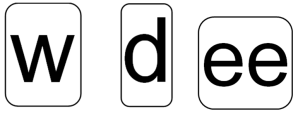

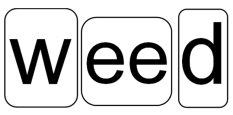
If you’re using magnetic letters, you can join two ‘e’ letters together with sticky tape.
You might think that giving your child all the right letters could this makes the task too easy, but it’s important to provide this kind of support (known as ‘scaffolding’ in education circles) when children are first learning new skills. The idea is to give them a greater chance of successfully completing a task.
When children are asked to do something without sufficient guidance they can easily become frustrated. Frustration can lead to negative emotions that leave them feeling discouraged.
With the right amount of scaffolding, children can achieve early success which helps to build confidence and improve motivation. It’s been said that “being able to do is very close to wanting to do”.3
Gradually Increase the Difficulty...
Although it’s important to provide support when children are learning new skills, it’s also important to gradually reduce the amount of support they get as they become more proficient in the skills they are learning.
Once your child can successfully construct a word using alphabet cards, ask them to write out the word by hand if they are reasonably proficient at writing.
For younger children who aren’t yet able to write fluently, you could continue using alphabet cards and increase the difficulty by getting them to construct the whole word from individual letters.
So, rather than giving them an ‘ee’ combination card you would provide them with individual letter e’s. You could also make things more difficult by providing them with more letters than they need.
If we use the example for spelling ‘weed’ again, once your child can spell it confidently with the letter combination cards as described above, you might provide them with the following letters:
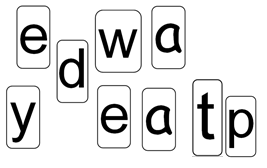
As you can see, this would represent a significant increase in the level of difficulty because your child would need to make choices about which letters to use as well as getting them in the right order.
However, using the alphabet cards or magnetic letters in this way still provides more support than trying to construct a word from the whole alphabet.
If your child struggles with these tasks, give them some hints…
For the example above, you might encourage your child to break the word down into its 3 sounds verbally ‘w’-‘ee’-‘d’. You could then ask: “what letter does weed start with?” And: “how do we make the ‘ee’ sound?”
When you repeat the exercise with your child on a different day, see if they can do the task successfully with fewer hints. Gradually reduce the support (scaffolding) each time until they can spell the word independently.
Ultimately, you want your child to be able to write out the correct spellings of words without any prompting, magnetic letters or alphabet cards, so it’s important to develop their handwriting skills alongside their spelling skills.
We explain how you can help your child to learn to write in a separate article and we discuss ways of making written spelling practice more effective in our article on spelling strategies.
One other point: you need to take some care about which words to include when you do tasks like the ones we’ve described above.
If the words contain other letter combinations that your child hasn’t met yet, this could confuse them. For instance, if you wanted your child to learn to spell the words cheep, sheet, and teeth, they would find it difficult if they hadn’t already met the other letter combinations highlighted in red.
Introduce Words With Alternative Spelling Patterns for the Same Sound…
Some sounds in the English Language can be represented by a variety of letters or letter combinations. For example, the ‘ee’ sound we mentioned above can also be represented by ‘ea’ in words such as eat, leaf and cream. And the same sound is represented by ‘ey’ in donkey and hockey.
Your child should practise spelling words like these as soon as they’ve learned to read them, but once again he or she will need some careful guidance and support…
Provide your child with the correct alphabet cards or magnetic letters when they first practise spelling the words (just as we explained in the example for spelling ‘weed’ above). So, if you want your child to spell ‘leaf’ you would give them the following cards in a random order and ask them to arrange the letters to spell the word:
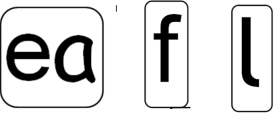

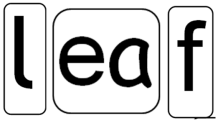
(You could also ask your child to spell the word ‘flea’ with these letters.)
As we mentioned previously, once your child can successfully construct a word using alphabet cards, ask them to write out the word by hand if they are reasonably proficient at writing.
For younger children who aren’t yet able to write fluently, you could continue using alphabet cards and increase the difficulty by getting them to construct the whole word from individual letters.
So, rather than giving them an ‘ea’ combination card you would provide them with an individual letter e and letter a. You could also make things more difficult by providing them with more letters than they need as we illustrated for the word ‘weed’.
Mix It Up
Once your child has mastered the alternative spelling patterns, ask them to spell lists of words that contain a mixture of spelling patterns for the same sound. For example, you might ask them to spell the following list of words:
feet leaf peek donkey eat tree cream hockey
If your child is a proficient writer, ask them to write the words out. If not, you could provide them with alternative combination cards with the same sound so they have to choose the correct ones.
For example, if you want them to spell ‘seat’ you might provide them with the following cards, (but explain that they don’t need them all):
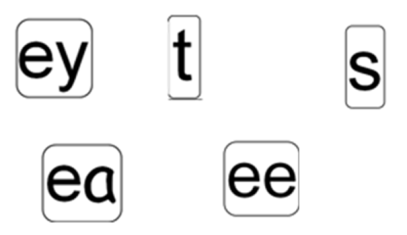
It’s important to mix it up like this because it forces your child think more deeply about each word, and this makes it more likely they will spell the words correctly in the future, even though it makes it more difficult for them in the practice session.
Mixing things up in this way is known as interleaving, and it’s been shown to boost long-term learning in a number of studies.4
However, it needs to be used carefully. Only use interleaving after your child has become quite good at spelling groups of words with similar sounds and spelling patterns. Mixing things up when your child is first learning to spell more difficult words can actually be counterproductive.
This step can be quite a leap for a beginning speller because there isn’t always an obvious pattern to indicate the correct choice. Some things just need to be learned through regular practice.
However, sometimes it is possible to find spelling patterns that can help, as we discuss below.
Encourage your child to look out for patterns…
Recognising patterns in spellings can improve your child’s chances of choosing the correct letters. For example:
- When an ‘o’ sound follows a ‘w’ sound the ‘o’ sound is often spelt using the letter ‘a’. For example, wasp, want, wash. This is also true for an ‘o’ sound after ‘qu’: squash, quarrel, squad.
- If a word ends in a ‘v’ sound, the spelling should have an ‘e’ at the end of it unless it‘s an abbreviation. For example, have, give, love.
- The ‘ey’ letter combination mostly appears at the ends of words or syllables, for example, donkey, hockey, galley, kidney, Mickey and beyond. With practice, your child will learn to recognise that ‘leyf’, ‘creym’, ‘eyt’ and ‘feyl’ just don’t look right because they don’t follow the pattern for the ‘ey’ letter combination.
- Words like toy, boil, boy, employ, coin and point all contain the same sound which is represented by the words in red. It’s helpful to be aware that the ‘oi’ version never appears at the end of words.
- Similarly, train, play, say and maid have a common sound and the ‘ai’ version never appears at the end of words.
- The sound that the ‘ou’ letter combination represents in words like out, cloud, round and shout can also be represented by ‘ow’ in words such as cow, brown, crown flower and how. ‘Ou’ is normally used at the beginning or middle of words or syllables and ‘ow’ mostly appears at the ends of words unless it is followed by an ‘n’, ‘l’ or ‘er’ as you can see in the examples above.
- The /k/ sound can be represented by the letter ‘k’ (kicking /k/), the letter ‘c’ (curly /k/) or the combination ‘ck’. If you provide your child with some examples of words containing this sound and ask them to identify how /k/ is represented at the beginning and the end of words they might notice the following:
- ‘ck’ is used mainly at the end of words or syllables, for example: ‘pick’, ‘duck’, ‘sock’, bucket, rocket. It is never used at the beginning of words.
- An individual ‘c’ or ‘k’ can appear at the end of words or syllables and at the beginning of words, for example, cat, crocodile, cost, picnic, public, talc, kick, keep, key, link, tank, milk.
Being aware of generalisations like these can reduce the burden on your child’s memory and improve their chances of choosing the correct letter combinations.
Learning to spell “tricky words”…
Tricky words are sometimes called “irregular words” or “exception words” and they might also be described as “Sight words”.
These are words that have some letters (or letter combinations) in them that are pronounced differently from the way they’re pronounced in regular words.
Fortunately, most tricky words contain some letters with more familiar pronunciations, and these can help children to read and spell tricky words once they’ve developed a good grasp of phonics.
You could introduce the basic idea of tricky words to your child by saying: “Letters can sometimes stand for more than one sound.”
Explain that spelling some words can be tricky because some of the letters that are used in them aren’t the ones we expect from the sounds in the word.
You could use a simple word such as ‘wash’ as an example. We might expect to spell this as ‘wosh’, but instead of a letter ‘o’ we use an ‘a’.
Ask your child to say how the word would sound if we pronounced the ‘a’ in the usual way (like it is in ‘cat’, or ‘tap’). This will help them to remember the correct spelling.
You could then give another example where the letter ‘a’ has the same sound as in wash, such as ‘watch’. Again, ask your child to say the word as it would sound if the letter ‘a’ had its usual sound.
At this point, it might be useful to give some examples where a different letter changes its normal sound, such as the letter ‘y’ in daddy and happy. In these words, and many others that end in a ‘y’, it sounds like ‘ee’.
We think it’s best to look at groups of tricky words with common patterns in their spellings or pronunciations rather than just focussing on the ones that occur most often in print.
For example, children should be made aware of all the different sounds for the letter ‘y’…
This has several pronunciations that are different from its sound in regular words like yes and yellow.
- As mentioned previously, when it is found at the end of a word it often sounds like ‘ee’, as in happy, Daddy and sunny (notice that this happens a lot after a double consonant, and also for a lot of words ending in ‘ky’ or ‘ly’, for example ‘cheeky’, ‘silky’, ‘slowly’ and ‘badly’).
- In some short words, a ‘y’ at the end can have the ‘igh’ sound as in by, my and sky. This isn’t as common as the ‘ee’ sound for a y.
- And ‘y’ can also have the same sound as ‘i’ for insect, for example in crystal, syrup and pyramid.
Try to be careful about the examples you use. For instance, don’t introduce the words ‘baby’ or ‘gym’ as examples of unusual ‘y’ sounds before you’ve covered alternative sounds for the letters ‘a’ and ‘g’.
You can also introduce groups of words with ‘silent’ letters and words with alternative sounds for the vowels.
For example, the vowel ‘a’ can have different sounds in different words:
- it has its common sound in words such as ‘bat’, ‘cap’ and ‘ant’;
- an ‘ai’ sound in ‘apron’, ‘baby’ and ‘lady’;
- an ‘o’ sound in wasp, want and swan (which often happens after a ‘w’); and
- it can sometimes have an ‘e’ sound, for example, ‘any’ and ‘many’.
Provide a variety of examples for each variation and teach children to read the words first.
Once children start to get the hang of reading the words they can practise spelling them, which is always a bit more difficult. This practice can be done with alphabet cards, magnetic letters or in writing, depending on how advanced your child’s handwriting is.
John Walker, the founder of the Sounds-Write programme, provides a good explanation of word building to help children read and spell the word ‘said’ in this article.
Once your child has seen a variety of groups of words with tricky spelling patterns you can focus on the tricky words that appear most often in print.
There are various sources you can use for common word lists. The words in each source vary slightly depending on which books were used for the research, but overall they are fairly similar, with most agreeing that ‘the’ is the most used word in English.
The list on this Wikipedia link was compiled by researchers from the Oxford English Dictionary: https://en.wikipedia.org/wiki/Most_common_words_in_English
If you research common word lists, you will notice that quite a lot of the words aren’t tricky at all, and many of the tricky words have only one or two tricky bits.
Identify What’s Tricky and What’s Not…
With any tricky word, the key thing is to identify which parts of the word have regular spellings and to think about and verbalise the parts of the word that have unusual spellings.
So, for example, with a word like yacht, your child should recognise that the first and last letters represent their most common sounds, but the middle 3 letters don’t. You could ask them to underline or highlight the part of the word that’s tricky –
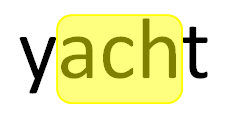
If you ask your child to pronounce a tricky word in a way that matches its spelling this can help them to remember the tricky part. For example:
- Yacht looks like it should contain 4 sounds: ‘y’- ‘a’- ‘ch’- ‘t’.
(Point out that in this word, ‘ach’ represents just one sound – the same sound as ‘o’ in hot). - If we pronounced the word Wednesday to match its spelling it would contain 3 syllables instead of 2: Wed – nes- day.
- Say the letter ‘o’ in the spelling of the word leopard, or, if your child is familiar with ‘leo’ (as in Latin for a lion), they could pronounce it as ‘leo’-‘pard’.
- Say ‘monkey’ in a way that rhymes with ‘wonky’ to highlight the unusual sound represented by the letter ‘o’. You could give another example where the letter ‘o’ represents the same sound – ‘mother’, which looks like it should rhyme with ‘bother’.
Analysing words in this way takes some time, but your child will be much more likely to remember the correct spelling in the future because they will have a verbal representation of the spelling in their memory as well as a visual one.5
Practise spelling homophones…
These can be some of the trickiest words to master because they have identical sounds but different spellings.
Examples include ‘pair’/’pear’, ‘buy’/ ‘by’/’bye’, ‘road’/’rode’/’rowed’, ‘horse’/’hoarse’, ‘tail’/’tale’, ‘there’/’they’re’/’their’, ‘your’/‘you’re’ and ‘to’/‘too’/’two’.
As the above video mentions, the correct spellings of these words can only be determined by considering how they are used in a sentence. So, one way to learn homophones might be to write sentences with alternative spellings of the words. Then encourage your child to choose the correct word from the alternatives. However, it’s best to explain the different meaning of each spelling first.
It’s also best to drip-feed examples of homophones, rather than blitzing your child with loads of them over a short period of time. Consequently, it would probably be unwise to start out with as many alternatives as the example below (but hopefully it illustrates the idea):
The man (road / rode / rowed) into town on a (horse / hoarse).
The (road / rode / rowed) was very busy.
Later, the man went (two / too / to) the river and (road / rode / rowed) a boat but he lost an (ore / oar).
Once your child can confidently select the right alternative for the homophones he or she is learning, you could ask them to write out the correct spelling from memory as you dictate the sentence. This is harder because they will no longer have the visual cue of seeing the different options.
There are some really helpful videos and activities about homophones (aimed at primary school children) on the BBC Bitesize site.
Learning to spell all the words in their vocabulary is a daunting task for any child and it takes time. However, as we’ve discussed, it can be broken down into manageable and meaningful chunks. This doesn’t make spelling easy, but it’s far more efficient and effective than trying to learn random lists of words by sight.
See our article, ‘Spelling Strategies for Kids’ to learn about some simple but effective tactics that can help your child remember spellings more efficiently.
And you might also want to have a look at another of our articles about spelling strategies you should avoid.
See below for other useful links.
Further Information…
The BBC Bitesize website has some very useful and child-friendly spelling videos and activities. Follow this link to access spelling tips for children in primary school and this link to see spelling tips for older children.
The Spellzone website is a fantastic online resource suitable for 7-year-olds to adults. It has some great word lists, activities and spelling games and you can also access a spelling ability test and a complete spelling course from the site. The course is suitable for anyone wanting to learn British or American Spelling.
If you have an academic interest in spelling, and would like to explore the research on spelling more fully, Kerry Hempenstall’s article, ‘Feel like a spell? Effective spelling instruction.’ is a good place to start.
If you would like more information about teaching your child to read then click on this link.
If you would like more information about teaching your child to write, see our article “How to Teach Handwriting”.
References:
- American Educator, Winter 2008-2009, How Words Cast Their Spell
- Hanna, P.R., Hanna, J.S., Hodges, R.E., and Rudorf, E.H., Jr. (1966). Phoneme-grapheme correspondences as cues to spelling improvement
- Marland, M. (1993), The Craft of the Classroom, Heinemann.
- Scientific American, August 2015, The Interleaving Effect: Mixing It Up Boosts Learning: https://www.scientificamerican.com/article/the-interleaving-effect-mixing-it-up-boosts-learning/
- Ladan Shams1 and Aaron R. Seitz2, Benefits of multisensory learning, Trends in Cognitive Sciences xxx No.x: http://faculty.ucr.edu/~aseitz/pubs/Shams_Seitz08.pdf